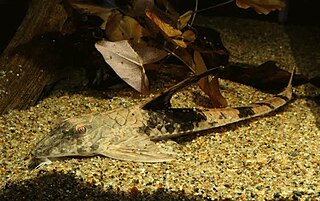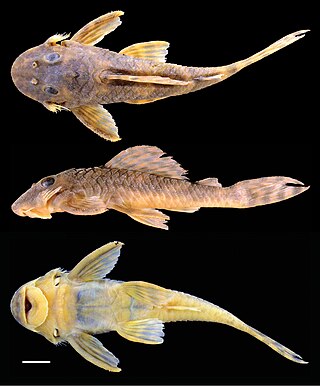
Loricariidae is the largest family of catfish, with 92 genera and just over 680 species. Loricariids originate from freshwater habitats of Costa Rica, Panama, and tropical and subtropical South America. These fish are noted for the bony plates covering their bodies and their suckermouths. Several genera are sold as "plecos", notably the suckermouth catfish, Hypostomus plecostomus, and are popular as aquarium fish.

Hypancistrus is a genus of loricariid catfish originating from the Amazon basin in South America. Unlike many of the other Loricariids, however, some Hypancistrus species are more carnivorous and enjoy meat in their diet. Hypancistrus species are popular aquarium fish, including such popular fish as the zebra pleco and Queen Arabesque pleco.

Hemiancistrus is a genus of suckermouth armored catfishes. These species are native to South America. The taxonomy of this genus is complex and unclear, and major work has to be done. Many of these fish are popular aquarium fish.

The Hypostominae are a subfamily of catfishes of the family Loricariidae. Most members are restricted to tropical and subtropical South America, but there are also several species in southern Central America. Hypostomus plecostomus, which is popular in the aquarium trade, has been introduced to several regions far from its native range.

Peckoltia sabaji is a species of catfish in the family Loricariidae. It is native to South America, where it occurs in the basins of the Rupununi, the Essequibo River, and the Takutu River in Guyana, as well as the basins of the Casiquiare canal, the Rio Negro, the Cinaruco River, and the Orinoco in Venezuela. It is usually found among boulders in medium to large rivers. The species reaches 19.8 cm SL and is of disputed classification.

Peckoltia vittata is a species of catfish belonging to the subfamily Hypostominae of the family Loricariidae.
Peckoltia multispinis, commonly known as the bristlemouth catfish, is a species of small freshwater fish in the genus Peckoltia of the catfish family Loricariidae. It has the L-number L049. It is possibly a junior synonym for Peckoltia vittata. However, the online Encyclopedia of Life lists this fish as Lasiancistrus multispinis. The California Academy of Sciences lists Peckoltia multispinis as the currently correct name. This species is not to be confused with the valid but unrelated species Ancistrus multispinis, and although A. multispinis has been used as a name for both this species and the one it is currently used for, A. multispinis was initially described as a member of the now-invalid genus Xenocara and was classified under that genus when this species was first described as a member of Ancistrus. Because of this, Ancistrus multispinis is a valid name, but not one that should be used for P. multispinis.
Panaque bathyphilus is an Amazonian species of armoured catfish from the family Loricariidae. The holotype of the species was collected in the Solimões River, upstream of its confluence with the Purus River. This species has been known in the aquarium trade, at least since 1992, as papa panaque or under the L-number code L090. It reaches up to about 40 cm (16 in) in length.
Peckoltia braueri is a species of catfish in the family Loricariidae. It is native to South America, where it occurs in the basins of the Rio Negro and the Branco River. It is typically found among large boulders in fast-moving riffles. The species reaches 10.3 cm SL.
Peckoltia caenosa is a species of catfish in the family Loricariidae. It is native to South America, where it occurs in streams in the llanos of Venezuela that are part of the Orinoco drainage basin. The streams that it inhabits are typically slow-flowing and muddy, and the species is often seen hiding inside submerged hollow logs during the day. The species reaches 15.7 cm SL. Its specific epithet is derived from a Latin word meaning "muddy" or "dirty", referring both to the species' mottled coloration and the muddy habitats in which it is found.
Peckoltia cavatica is a species of catfish in the family Loricariidae. It is native to South America, where it occurs in the Rupununi basin in Guyana. It is found in areas with large amounts of lateritic rock, and it is usually seen in holes and caves within the rock, which are also where it is thought to breed. P. cavatica's preference for such environments was notable enough to the authors of its 2005 description, Jonathan W. Armbruster and David C. Werneke, that the specific epithet bestowed upon it means "living in caves" in Latin. The species reaches 7.2 cm SL.

Peckoltia compta is a species of catfish in the family Loricariidae. It is native to South America, where it occurs in the Tapajós basin in Brazil. The species reaches 6.2 cm SL. It was described in 2010 by Renildo Ribeiro de Oliveira and Jansen Zuanon, Lúcia Rapp Py-Daniel, and Marcelo Salles Rocha primarily on the basis of coloration and patterning. Its specific epithet, compta, is stated to be derived from the Latin word for "adorned" or "ornamented", referring to the species' distinctive color pattern.
Peckoltia furcata is a species of catfish in the family Loricariidae. It is native to South America, where it occurs in the Ucayali River basin in Peru. The species reaches 9.2 cm SL. While not common in the trade, it is sometimes kept in aquaria, although it has no associated L-number or widely used common name.
Peckoltia lineola is a species of catfish in the family Loricariidae. It is native to South America, where it occurs in the basins of the Ventuari River in Venezuela and the Inírida River in Colombia. The species reaches 9.7 cm SL and is typically found in rocky riffles. Its specific epithet, lineola, derives from a Latin word meaning "line", referring to the lines present on the species' compound pterotic.

Peckoltia lujani is a species of catfish in the family Loricariidae. It is native to South America, where it occurs in the Orinoco and Meta River basins in Venezuela and Colombia. The species reaches 7.5 cm SL.
Peckoltia oligospila is a species of catfish in the family Loricariidae. It is a freshwater fish native to South America, where it occurs in the lower Amazon River basin in Brazil. The species reaches 10.5 cm SL. It appears in the aquarium trade, where it is typically referred to either by its associated L-number, which is L-006, or as the brown-dot peckoltia.

Peckoltia wernekei is a species of catfish in the family Loricariidae. It is native to South America, where it occurs in the Ventuari River, which is a tributary of the Orinoco in the state of Amazonas in Venezuela. The species reaches at least 10.46 cm SL.
Spectracanthicus zuanoni is a species of catfish in the family Loricariidae. It is native to South America, where it occurs in the Xingu River basin in the state of Pará in Brazil. It is usually found in areas up to 2 m deep with strong currents and rocky substrates, where it is often seen hiding beneath rocks. It is known to occur individually or in groups of three, with juveniles being found alongside other loricariid species, such as Ancistrus ranunculus, Baryancistrus xanthellus, Hopliancistrus tricornis, Parancistrus nudiventris, Peckoltia vittata, and its congener Spectracanthicus punctatissimus.
Ancistomus feldbergae is a species of catfish in the family Loricariidae. It is native to South America, where it occurs in the Xingu River basin in Brazil.
Ancistomus snethlageae is a species of catfish in the family Loricariidae. It is native to South America, where it occurs in the Tapajós basin in Brazil. The species reaches 22 cm in total length. Although originally described as a species of Ancistrus in 1911 by Franz Steindachner and subsequently reclassified in the genera Hemiancistrus, Lasiancistrus, and Peckoltia, a 2015 review conducted by Jonathan W. Armbruster, David C. Werneke, and Milton Tan listed the species as valid within Ancistomus.










